
Decisions are an unavoidable part of everyday governance and leadership. No matter how prepared (or unprepared) your board members are to make wise decisions, they’re constantly faced with new choices each day.
Whether they’re discussing financial or program-related matters, a lot relies on effective board decision-making. The direction your organization heads depends on these choices. This is especially true as your board members collaborate remotely and your nonprofit faces the pandemic’s unpredictable and changing circumstances. As such, it’s essential to build out your strategies and take extra steps to set your team up for success.
At Boardable, we’ve supplied thousands of nonprofit boards with the tools they need to refine their management processes. We’ve witnessed effective decision-making procedures as well as ineffective approaches, so we’re confident that we can help your board. We’ll go over ways to improve its strategies, engage in more productive conversations, and arrive at decisions quicker. Here are the three tried-and-true tips that we’ll cover:
- Define your board voting process.
- Encourage active participation in the boardroom.
- Implement technology to streamline decision-making.
Even if your board already makes effective choices, it doesn’t hurt to revisit and refine your approach. You may wind up finding ways to increase efficiency and make conversations more insightful. Let’s dive in.
1. Define your board voting process.
Poor decision-making often stems from unclear guidelines, so first and foremost, focus on defining your nonprofit’s voting process. Check your bylaws for any specific requirements first. At nonprofits that don’t define their voting guidelines themselves, many follow Robert’s Rules of Order, which is a manual of parliamentary procedures to help maintain order during meetings. This provides a strong framework that will help all aspects of your board’s meetings, specifically with decision-making.
Boardable’s guide to board voting features a graphic that concisely explains how the board voting process works when following this approach. Here’s how it works:
Whether you use these steps or create your own guidelines, a standardized approach will ensure everyone’s on the same page. Robert’s Rules or any similar procedures may seem intimidating at first since they’re very thorough. With a little practice and training, board members will quickly grow accustomed to following these procedures.
Recording Votes
At this stage, you’ll also want to define how your minutes-taker records the vote. It should be obvious what the outcome was. For instance, you could clearly state whether the motion passed or failed, or you could get more specific. Say how many votes were in favor and against the motion.
If you’re sticking to Robert’s Rules of Order for recording votes, here’s the standard approach:
- Voting by show of hands: Simply record whether the motion passed or failed, or list the total number of votes for each side.
- Voting by ballot: Record the total number of board votes for each side. This approach is reserved for more sensitive decisions to avoid inadvertently creating tension in the board room.
- Voting via roll call: Attach each member’s name to their vote in the minutes. While not as common, your bylaws will usually indicate whether this is required.
Once you’ve narrowed down all the specifics of your voting procedures, walk through them step-by-step with board members. With enough training, your team will nail the process down. You’ll have much more time to focus on having insightful discussions rather than navigating confusing processes.
2. Encourage active participation in the boardroom.
Meetings are when board members engage in face-to-face debate and conversations. Open discussion and consensus-building offer the ability to arrive at the best possible decisions. When board members don’t participate, it leads to less effective decision-making and risks damaging board member engagement.
To encourage board members to weigh in on decisions, consider the following innovative strategies:
- Turn the agenda upside down. The more decisions your board members make, the more susceptible they are to “decision fatigue,” which can compromise the quality of decisions. Try restructuring your agenda by placing the most pressing items first. Otherwise, attendees may tune out toward the end of the meeting.
- Set guidelines for remote voting. re:Charity’s virtual board meetings guide explains that “those who phone-in usually only listen and vote on motions, which poses an inherent risk to productivity.” Many nonprofit leaders also warn against voting by email, because board members can’t hear all sides, especially for important decisions. However, it’s unavoidable in some circumstances. Decide the specific cases where remote voting is permissible. Then, to improve remote voting quality, try out video conferencing whenever you host virtual board meetings.
As we continue to navigate the remote landscape, encouraging participation is vital if you want to promote strong communication and decision-making. Active participation will naturally ensure all voices are heard, so pay attention to which strategies improve the boardroom’s atmosphere. In turn, your board members will become more comfortable sharing their opinions and insights, giving everyone a say in the matters at hand.
3. Implement technology to streamline the process.
Society’s reliance on technology continues to grow. What this means for nonprofits is that there are endless solutions that streamline operations, including board management.
With social distancing guidelines in place, the ability to engage and vote remotely is more imperative than ever. Luckily, effective board management software often comes equipped with virtual voting and polling technology. That way, you can maintain momentum remotely and make quick, high-priority decisions when your nonprofit needs help the most.
Your software’s core function should be to create polls and collect votes, but realistically, you’ll need more robust capabilities than that. Look for technology that offers the following core features:
- Mobile access. Ensure your board members can check for any active polls from their mobile devices. That way, they can participate even if they forget their laptop during your in-person meeting or aren’t able to attend in-person at all.
- Anonymous voting. For sensitive issues, make sure you can enable anonymous voting so everyone feels comfortable sharing their honest opinions.
- A dashboard. Make sure all past and upcoming polls are displayed in each board member’s dashboard. That way, they can reference past decisions and come prepared to your meetings for upcoming ones.
Your technology can make a significant difference in your organization’s decision-making process. By selecting tools that are easy to use, your board will spend less time counting votes and more time progressing toward your nonprofit’s mission. With the right software, board members can easily vote, record whether the motion passed, and move on to the next agenda item.
Your nonprofit’s success depends on the decisions your board makes. In other words, board voting is not something your team should overlook.
Start by defining your voting procedures and reviewing them in-depth with board members. Then, work to create a more collaborative environment with the help of innovative board management technology. In turn, you’ll boost board engagement and adopt smarter decision-making skills that support your mission. Good luck!
Author: Jeb Banner
Jeb is the founder and CEO of Boardable, a nonprofit board management software provider. He is also the founder of two nonprofits, The Speak Easy and Musical Family Tree, as well as a board member of United Way of Central Indiana and ProAct. Jeb is based in Indianapolis, Indiana.


